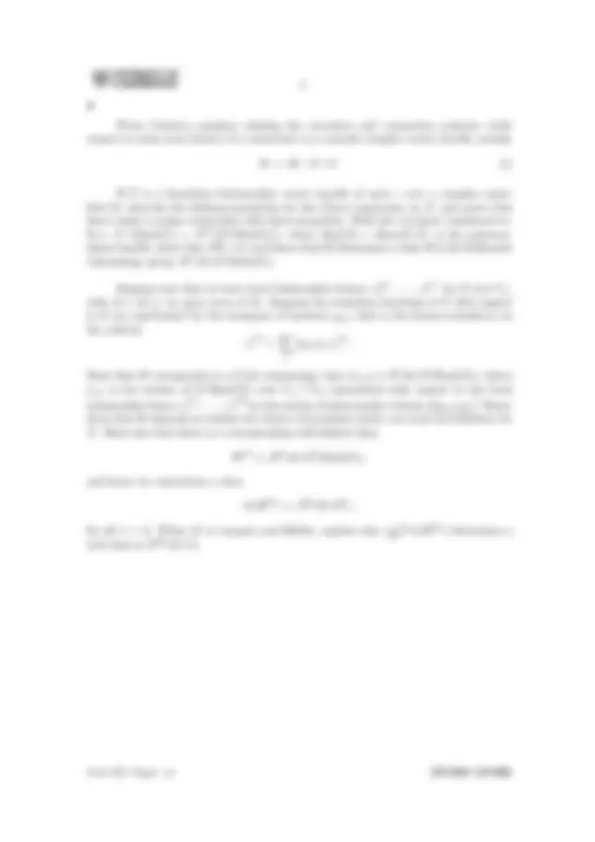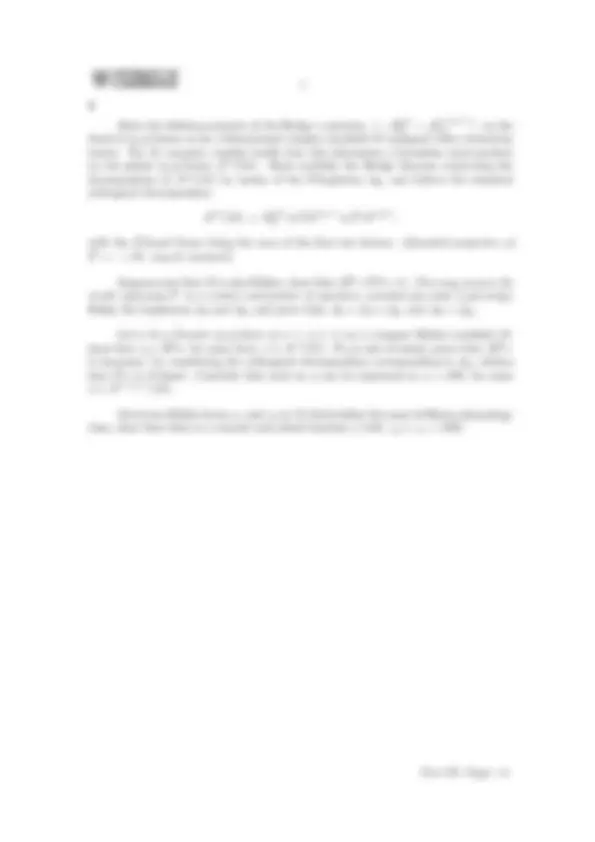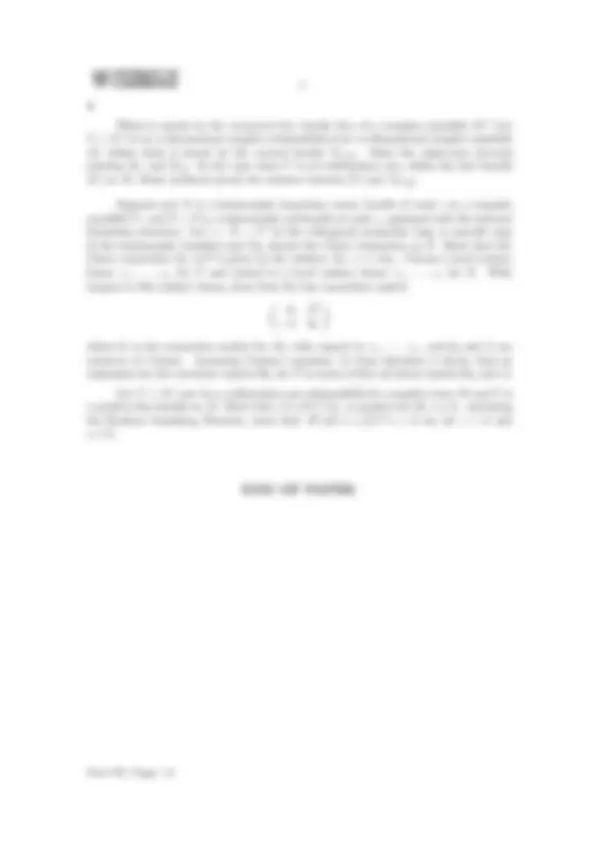





Study with the several resources on Docsity

Earn points by helping other students or get them with a premium plan


Prepare for your exams
Study with the several resources on Docsity

Earn points to download
Earn points by helping other students or get them with a premium plan
Community
Ask the community for help and clear up your study doubts
Discover the best universities in your country according to Docsity users
Free resources
Download our free guides on studying techniques, anxiety management strategies, and thesis advice from Docsity tutors
The questions and instructions for paper 13 of the mathematical tripos part iii exam, focusing on complex manifolds and vector bundles. Topics include showing the existence of a holomorphic function, deducing a short exact sequence of sheaves, explaining the properties of a non-zero smooth form, and proving cartan's equation. Students are required to attempt no more than three questions from the four provided.
Typology: Exams
1 / 5

This page cannot be seen from the preview
Don't miss anything!




Wednesday, 2 June, 2010 1:30 pm to 4:30 pm
Attempt no more than THREE questions. There are FOUR questions in total. The questions carry equal weight.
Cover sheet None Treasury Tag Script paper
You may not start to read the questions printed on the subsequent pages until instructed to do so by the Invigilator.
Given holomorphic functions f 1 ,... , fn on a polydisc ∆n^ ⊂ Cn^ centred at a point a = (a 1 ,... , an) with ∂fi/∂zj = ∂fj /∂zi for all i, j, show that there exists a holomorphic function f on ∆n^ such that ∂f /∂zi = fi − fi(a) for all i. [Hint: Define f (z 1 ,... , zn) as a certain sum of n integrals; standard facts from Analysis may be assumed.]
Let M be a complex manifold of dimension n. If Ω (^) M^1 denotes the sheaf of holomorphic 1-forms, and Ω˜^1 M denotes the subsheaf of closed holomorphic 1-forms, deduce that there is a short exact sequence of sheaves
0 → C ֒→ OM −→∂ Ω˜ (^) M^1 → 0.
If M is now assumed to be compact, show that any global complex-valued function f with ∂ ∂f¯ = 0 must be constant. [You may assume that for any non-constant harmonic function g on a domain in C, there are no local maxima for |g|.]
Still assuming that M is compact, suppose that θ is a non-zero smooth (n, 0)-form on M ; explain why the integral over M of the (n, n)-form θ ∧ θ¯ is non-zero. If ψ denotes a holomorphic (n − 1)-form on M , deduce that ψ is closed.
Suppose now that n = 2 , so that M is a compact complex surface. Show that there is an inclusion H^0 (M, Ω^1 M ) ֒→ HDR^1 (M, C) into the first de Rham cohomology group. Prove that H^0 (M, Ω (^) M^1 ) ∩ H^0 (M, Ω (^) M^1 ) = 0
in H (^) DR^1 (M, C), and hence that 2h^1 ,^0 6 b 1 , where b 1 = dimC H (^) DR^1 (M, C). From the above short exact sequence of sheaves, prove furthermore that b 1 6 h^1 ,^0 + h^0 ,^1 , and hence that h^1 ,^0 6 h^0 ,^1. Give an example of a compact complex surface for which this last inequality is strict.
Part III, Paper 13
State the defining property of the Hodge ∗-operator, ∗ : A (^) Mp, q → A (^) Mn− p, n−q, on the sheaf of (p, q)-forms on an n-dimensional complex manifold M equipped with a hermitian metric. For M compact, explain briefly how this determines a hermitian inner-product on the global (p, q)-forms Ap, q(M ). State carefully the Hodge theorem concerning the decomposition of Ap, q(M ) by means of the ∂¯-Laplacian ∆∂¯ , and deduce the standard orthogonal decomposition
Ap, q(M ) = H (^) ∂p, q ¯ ⊕ ∂A¯ p, q−^1 ⊕ ∂¯∗Ap, q+1^ ,
with the ∂¯-closed forms being the sum of the first two factors. [Standard properties of ∂^ ¯∗^ = − ∗ ∂¯∗ may be assumed.]
Suppose now that M is also K¨ahler; show that ∂ ∂¯∗^ + ∂¯∗∂ = 0. [You may assume the result expressing ∂¯∗^ as a certain commutator of operators, provided you state it precisely.] Define the Laplacians ∆d and ∆∂ , and prove that ∆d = ∆∂ + ∆∂¯ and ∆∂ = ∆∂¯.
Let η be a ∂¯-exact (p, q)-form (p > 1, q > 1) on a compact K¨ahler manifold M ; show that η = ∂¯ ∂¯∗α for some form α ∈ Ap, q(M ). If η is also ∂-closed, prove that ∂ ∂¯∗α is harmonic; by considering the orthogonal decomposition corresponding to ∆∂ , deduce that ∂¯∗α is ∂-closed. Conclude that such an η can be expressed as η = ∂ ∂φ¯ for some φ ∈ Ap−^1 , q−^1 (M ).
Given two K¨ahler forms ω 1 and ω 2 on M which define the same de Rham cohomology class, show that there is a smooth real-valued function f with ω 2 = ω 1 + i∂ ∂f¯.
Part III, Paper 13
What is meant by the canonical line bundle KM of a complex manifold M? Let V ⊂ M be an n-dimensional complex submanifold of an m-dimensional complex manifold M ; define what is meant by the normal bundle NV /M. State the adjunction formula relating KV and KM. In the case when V is of codimension one, define the line bundle [V ] on M. State (without proof) the relation between [V ] and NV /M.
Suppose now E is a holomorphic hermitian vector bundle of rank r on a complex manifold V , and F ⊂ E is a holomorphic subbundle of rank s, equipped with the induced hermitian structure. Let π : E → F be the orthogonal projection map (a smooth map of the holomorphic bundles) and DE denote the Chern connection on E. Show that the Chern connection DF of F is given by the relation DF = π ◦ DE. Choose a local unitary frame e 1 ,... , es for F and extend to a local unitary frame e 1 ,... , er for E. With respect to this unitary frame, show that DE has connection matrix ( θ 1 A¯t −A θ 2
where θ 1 is the connection matrix for DF with respect to e 1 ,... , es , and θ 2 and A are matrices of 1-forms. Assuming Cartan’s equation (†) from Question 2 above, find an expression for the curvature matrix ΘF for F in terms of the curvature matrix ΘE and A. Let V ⊂ M now be a codimension one submanifold of a complex torus M and L is a positive line bundle on M. Show that (L ⊗ [V ]⊗a)|V is positive for all a > 0. Assuming the Kodaira Vanishing Theorem, show that Hi(M, L ⊗ [V ]⊗a) = 0 for all i > 0 and a > 0.
Part III, Paper 13